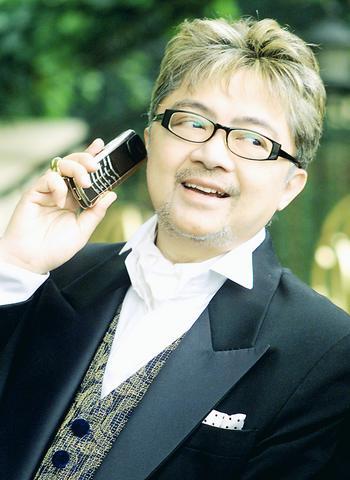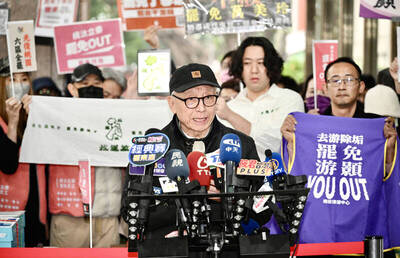For Asia's hip and swanky, carrying a mobile phone with a cracked screen and a tatty plastic cover is tantamount to a crime against fashion.
Instead, a Prada ensemble with Gucci loafers or Manolo Blahnik stilettos demands nothing less than a diamond-encrusted handset from China's TCL Mobile Communication Co Ltd or an 18-carat white gold mobile with a sapphire crystal face by Nokia unit Vertu.

Indonesian haute couture designer Harry Darsono, 54, carries a US$26,550, 215-gram platinum Vertu cellphone to match his Lanvin shirts and Hugo Boss shoes when he entertains customers.
"I am very fussy. My handphone, handbag and attire must be part of the overall art of presentation to the clients -- you need to use their language so you can be close to them," said Darsono, who was educated in France and collects vintage pianos and luxury cars.
While mobile makers are tight-lipped on revenues from their luxury segments, analysts say high-end sales could provide a lift as penetration rates level off and the take-up of high-speed data services remains lackluster.
"Luxury and glamor models offer a different level of interest and engagement for consumers, which would spur them on to buy more new and beautiful phones," said Ian Woodward, a consumer behavior researcher at Australia's Griffith University.
London-based Vertu and Finnish parent Nokia, the world's top handset maker, began developing the luxury models as early as 1997, Vertu President Nigel Litchfield said.
"As the industry became increasingly saturated in the last few years, manufacturers were compelled to discover new markets and identify upcoming trends in mobile phone consumption."
At the end of last year, Asia accounted for a third of Vertu's total business, Litchfield said, adding that Hong Kong was its largest single market.
Shiv Putcha, senior analyst with The Yankee Group, believes fashion phones could invigorate sales for handset makers, as slow data download speeds, poor content and handset glitches leave users disappointed with 2.5G and third-generation (3G) networks.
"Most of the models in the market do not address the consumer's need for increased personalization, and I believe this to be a significant driver of growth," he said.
Given Asia's high cellphone replacement rate -- every nine to 18 months compared with about two years for Europe and the US -- the region is the logical market to launch iconic handsets, Putcha said.
Motorola Inc, the world's second-largest cellphone maker, said its line of fashion phones enjoyed triple-digit growth rates in the first quarter of this year over the final three months of 2003 in Southeast Asia, Australia, New Zealand, India, Bangladesh and Pakistan.
"In Asia, phones are much more of an aspirational statement about who you are and who you want to be," Scott Durchslag, a Motorola corporate vice president said.
Motorola recently launched a clamshell V600 model that offers interchangeable covers studded with clear Swarovski crystals, and Nokia's new 7200 model offers fabric covers that have analysts calling it the Louis Vuitton phone.
Gem-encrusted handsets also became the rage in China, the world's largest wireless market, after TCL Mobile made waves in 2000 with the launch of its diamond-studded mobile phones.
Its limited edition range with genuine gemstones costs up to 20,000 yuan (US$2,400).
TCL Mobile, which is seeking a separate listing in Hong Kong and is 40.8 percent-owned by TCL International Ltd, controls about one-tenth of China's cellphone market.
"Attaching jewellery on the phone adds a cultural and spiritual dimension to the product," TCL Mobile's managing director, Wan Ming Jian said.
"To many Chinese, precious stones symbolize esteem, good fortune, peace and love. So jewelled mobile phones are not just communication tools, they also act as lucky charms," he said.
TCL Mobile sold more than 12 million jewelled phones -- most of which had fake gems -- between 2001 and the first six months of last year.

The Democratic Progressive Party (DPP), Chinese Nationalist Party (KMT), and the country’s other political groups dare not offend religious groups, says Chen Lih-ming (陳立民), founder of the Taiwan Anti-Religion Alliance (台灣反宗教者聯盟). “It’s the same in other democracies, of course, but because political struggles in Taiwan are extraordinarily fierce, you’ll see candidates visiting several temples each day ahead of elections. That adds impetus to religion here,” says the retired college lecturer. In Japan’s most recent election, the Liberal Democratic Party lost many votes because of its ties to the Unification Church (“the Moonies”). Chen contrasts the progress made by anti-religion movements in

Taiwan doesn’t have a lot of railways, but its network has plenty of history. The government-owned entity that last year became the Taiwan Railway Corp (TRC) has been operating trains since 1891. During the 1895-1945 period of Japanese rule, the colonial government made huge investments in rail infrastructure. The northern port city of Keelung was connected to Kaohsiung in the south. New lines appeared in Pingtung, Yilan and the Hualien-Taitung region. Railway enthusiasts exploring Taiwan will find plenty to amuse themselves. Taipei will soon gain its second rail-themed museum. Elsewhere there’s a number of endearing branch lines and rolling-stock collections, some

Last week the State Department made several small changes to its Web information on Taiwan. First, it removed a statement saying that the US “does not support Taiwan independence.” The current statement now reads: “We oppose any unilateral changes to the status quo from either side. We expect cross-strait differences to be resolved by peaceful means, free from coercion, in a manner acceptable to the people on both sides of the Strait.” In 2022 the administration of Joe Biden also removed that verbiage, but after a month of pressure from the People’s Republic of China (PRC), reinstated it. The American

This was not supposed to be an election year. The local media is billing it as the “2025 great recall era” (2025大罷免時代) or the “2025 great recall wave” (2025大罷免潮), with many now just shortening it to “great recall.” As of this writing the number of campaigns that have submitted the requisite one percent of eligible voters signatures in legislative districts is 51 — 35 targeting Chinese Nationalist Party (KMT) caucus lawmakers and 16 targeting Democratic Progressive Party (DPP) lawmakers. The pan-green side has more as they started earlier. Many recall campaigns are billing themselves as “Winter Bluebirds” after the “Bluebird Action”